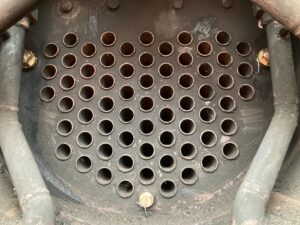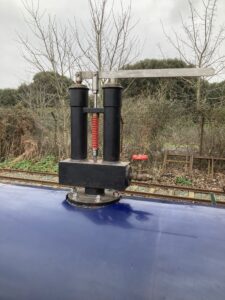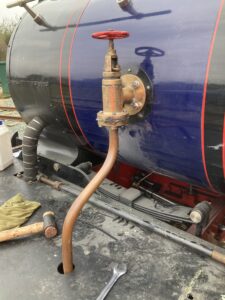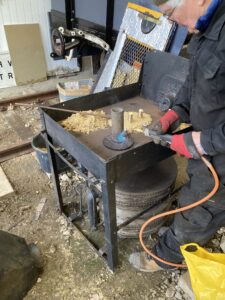With Stuart Hart able to give us another days work some good progress has again been made on Blyth.
 After much grunting and use of the weight available (actual weights hidden to protect the guilty!) hanging on various extension bars all of the wash out bushes have now been cleaned with taps and the new parallel threaded plugs fitted with carefully wrapped PTFE tape and new soft copper washers including these three in the smoke box.
After much grunting and use of the weight available (actual weights hidden to protect the guilty!) hanging on various extension bars all of the wash out bushes have now been cleaned with taps and the new parallel threaded plugs fitted with carefully wrapped PTFE tape and new soft copper washers including these three in the smoke box.
We then started to cut the new meter square sheet of gasket material about to make gaskets for the safety valve and port side clack valve.
 Stuart’s seemingly endless tool box produced some punches which made making the required holes much more easy. A dab of steam seal was placed around the main openings either side of the gaskets then the studs (new mild steel ones in the case of the safety valve) were tightened down. Despite wearing plastic gloves yours truly still bears the blackened fingers that goes with ths job!
Stuart’s seemingly endless tool box produced some punches which made making the required holes much more easy. A dab of steam seal was placed around the main openings either side of the gaskets then the studs (new mild steel ones in the case of the safety valve) were tightened down. Despite wearing plastic gloves yours truly still bears the blackened fingers that goes with ths job!
 All the above means that the boiler is now almost water tight up to fire box crown level, just the two redundant side bushes to weld up.
All the above means that the boiler is now almost water tight up to fire box crown level, just the two redundant side bushes to weld up.
Having taken a shortish lunch break, Stuart was very keen for us to get back to the tools, we turned our attention to the fusible plugs and their bushes in the crown of the fire box. Having wedged Stuart into the ash pan hole he did some cleaning of the threads of the bushes before starting to use the tap to fully clean the threads. These were particularly claggy due to the originals being shorter than the bushes allowing water and other sludge to pool.
Fusible plugs have a coarsely threaded hole through the centre which is filled with lead. This lead will melt should there be insufficient water above the fire box crown allowing its temperature to rise above safe levels. The noisy release of steam into the fire will alert the driver and fireman so they can take steps to drop the fire before more serious damage occurs.
 Our new plugs needed to have this lead melted into them so our newly donated forge was put to use using another of Stuart’s special tools – a steel crucible. This crucible and the plugs were heated with plenty of flux in them to clean things through then some old roof lead, cut in to strips, was popped in the crucible (don’t worry, the lead was not borrowed from the church roof Russ). Once molten the lead was carefully poured into the plugs, which you can just see resting on a bed of sand in the photo, and left to cool. When cool enough to handle, the excess lead was peeled away leaving two plugs ready to use.
Our new plugs needed to have this lead melted into them so our newly donated forge was put to use using another of Stuart’s special tools – a steel crucible. This crucible and the plugs were heated with plenty of flux in them to clean things through then some old roof lead, cut in to strips, was popped in the crucible (don’t worry, the lead was not borrowed from the church roof Russ). Once molten the lead was carefully poured into the plugs, which you can just see resting on a bed of sand in the photo, and left to cool. When cool enough to handle, the excess lead was peeled away leaving two plugs ready to use.
